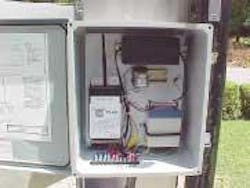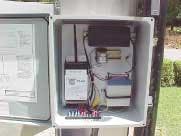Utility Avoids Sewer Overflows with Wireless Telemetry
Springfield, TN, located 25 miles from Nashville, has a population of just above 14,000. While it isn't a small town, the city's utility department doesn't have the same kind of manpower or technology resources that much larger cities have.
But in Springfield, just as in most places, it really stinks when the sewer backs up and overflows. Nobody wants it to happen – least of all the city wastewater department, which, in addition to fielding complaints from unhappy residents and businesses, gets slapped with a notice of violation (NOV) from the Tennessee Department of Environment and Conservation. These NOVs, if not addressed, can lead to stiffer penalties.
To keep the sewers from overflowing, the city water and wastewater department, headed by Johnny McDonald, was conducting daily checks at the eight sewer lift stations throughout Springfield. This meant personnel had to drive from site to site each day, consuming time and tying up employees and equipment.
Things began to change during one of the state's Tennessee Association of Utility Districts conferences, when McDonald encountered fixed-asset monitoring products from Teletouch. After assessing how the wireless telemetry devices could be used to help the city, McDonald did some research on wireless telemetry and the different companies offering the technology.
Budget and features were McDonald's chief concerns. The city didn't have an extensive amount of money to spend on a new automated checking system, and the wastewater department wasn't interested in features it would never use. As McDonald reviewed his options, he recognized that Teletouch's TT-501 fixed-asset monitoring system had the notification features he needed and fell within his budget.
"The Teletouch products were the most cost-effective of the bunch," he said, noting that many of the automation and notification devices he had reviewed had too many features, driving up their cost significantly. McDonald ordered eight TT-501 units – one each for the city's eight lift stations.
The TT-501, which operates using the overhead control channel of the cellular network (the same channel that provides a cell phone user with the information that he has missed a call or received a voicemail), is a multi-purpose input/output interface that can be added to remote equipment to provide wireless monitoring and remote control capability.
The TT-501 has four inputs that are selectable for contact, voltage or open-collector (switched ground) operation. The device's output is a remotely controllable Form C 2A 24 vDC dry-contact relay supporting normally open operation. The monitoring system also is connected to a Web site that enables users to view unit event and notification histories, set up notification options and customize notification text, remotely switch the auxiliary output and remotely query input or radio status.
The Springfield units went online in July 2003. Each device provides 24-hour monitoring of sewer levels at the lift stations. If the level reaches a certain point, the device sends a message to an alphanumeric pager worn by the on-duty wastewater department employee. It can also send a notification e-mail to the water and wastewater department computer. This instant notification enables the department to send personnel to correct the problem before the sewer overflows, thus avoiding the environmental danger, the NOV and the unpleasant smell.
"It has helped us reduce the number of NOVs we receive by 75 percent," McDonald said.
Because the Teletouch devices provide constant monitoring, the on-site checks are conducted every other day, leaving the department personnel free to address other water and wastewater concerns.
In addition, the system cuts overtime costs. Prior to using the fixed asset monitoring devices, each time the sewer overflowed at night or on weekends, it would cost the city a minimum of two hours overtime pay. Even when the problem resolved itself before the employee got to the site, the employee would still have to go to the site to send out an "all clear" message. With the wireless telemetry system, an automatic all clear is sent if the problem resolves itself.


